Osmosis is the process by which the solvent enters the area from low density to high density. In this case, two different densities of a solution are separated by a differential permeable membrane. The kidneys play an important role in the osmoregulation of fish. However, most of the osmoregulatory functions are performed by other organs such as the gills, skin and even the intestines.
Osmoregulation is a type of homeostasis that controls the concentration of water and ions. Basically, osmoregulation refers to the ability of a fish to maintain a suitable environment inside the body due to osmotic pressure. As a result, there is always a moderate difference in the concentration of intracellular and extracellular ions.
Numerous techniques have been developed in the body of fish to control the various problems caused by osmosis. The most common of these strategies are (1) Osmoregulation between intracellular and extracellular cells; (2) Osmoregulation between extracellular chamber and external environment. According to Rudolf Hober, the above two strategies are collectively called osmoregulatory techniques.
You might also read: Endocrine System of Fishes
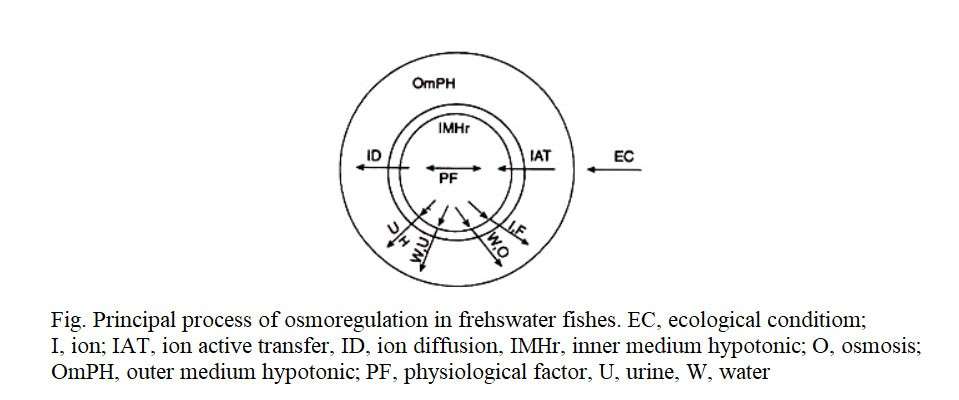
Osmotic exchanges between fish and their environment are of two types, viz
(1) Obligatory exchanges-it occurs by responding to a physical factor over which the animal has little or no physiological control;
(2) Regulatory exchanges – Such exchanges are physiologically well-regulated and play a role in controlling internal homeostasis.
Factors Affecting Obligatory exchanges
1. Gradient between the Extracellular Compartment and the Environment: There is more variation in an ionic density between body fluids and the external environment ion diffusion is more likely to occur at lower densities. This is why a bony fish in hypertonic seawater has to face the problem of losing water.
2. Surface/Volume Ratio: Usually small fish of the same size lose water and reabsorb it much faster than large fish.
3. Permeability of the Gills: Fish gills are more permeable to water and dissolved components. Gills are a major source of oxygen and carbon dioxide exchange between blood and water. The active transport of salt occurs in the gills. Euryhaline fish (fish that are able to tolerate higher levels of osmolarity) are better adapted to saltwater by reducing water permeability.
4. Feeding: Fish take water and dissolved components with food. Fish gills consume more salt than water when taken sea shore invertebrates as food. Fish have some special techniques to remove excess salt. Freshwater fish consume more water than salt. Therefore special techniques are required for salt conservation.
Osmoregulators and Osmoconfirmers: Osmoregulators are those animals that are capable of controlling different intra-osmolartiy from the environment. Fish that are actual osmoregulators are able to control the concentration of body fluids. All of these fish migrate to freshwater and salt water and can control the change in osmotic pressure caused by environmental changes through endocrine techniques.
Osmoconfirmers are those animals that are not able to control the osmotic state of their body fluids but ensure the osmolarity of the surrounding medium. Most fish live in fresh or salt water. In various physiological processes, waste products are excreted out of the body as a result of metabolism through the intestines, skin and kidneys in vertebrates. However, the gills of fish and aquatic animals are permeable to water and salt.
Due to the high salt content of seawater, salt enters the body due to osmosis and the water is removed. Marine fish drink water to fill the water vacuum. Salt enters the body due to differences in density. As a result, the concentration of salt inside the body increases. On the other hand, in the case of freshwater fish, salt is excreted outside the body (environment) due to the high concentration of salt inside the body.
As a result of osmosis, water enters the body through the permeable membrane. In this method, water enters a higher density solution but the fluid flows in the opposite direction. There is a difference in the relative penetration of these two types of molecules. Usually the solvent quickly passes through the membrane.
Osmoregulation in Freshwater Fishes
The body fluids of freshwater fish are more osmotic than the surrounding aquatic medium. Due to this, fish face two types of osmoreguatory problems in the water, such as:
1.Water enters the body due to high osmotic body fluids and differences in osmotic pressure. As a result, the body of the fish swells.
2. Due to the low concentration of salt in the surroundings, their bodies constantly lose salt, so freshwater fish have to prevent excess water from entering their bodies and losing excess salt. The kidneys produce large amounts of less density urine to eliminate excess water.
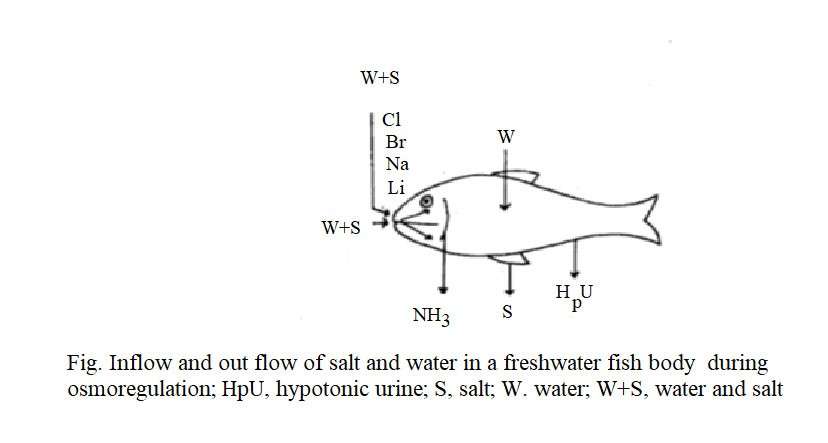
Most of the essential salts are reabsorbed into the bloodstream through the renal arteries and low density urine is produced. However, some biologically important salts such as potassium chloride (KCl), sodium chloride (NaCl), calcium chloride (CaCl2), magnesium chloride (MgCl2) are removed with the urine causing severe deficiency.
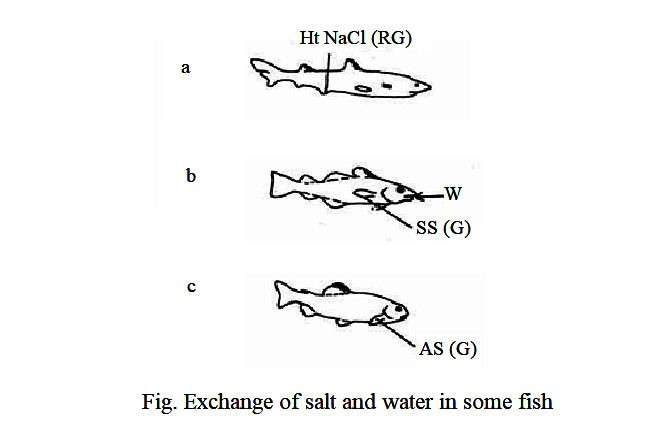
(a) Marine elasmobranch do not drink water and their isotonic urine exists; (b) Marine teleosts drink water and they also have isotonic urine;(c) Freshwater teleosts do not drink any water and their acute hypotonic urine exists. [ AS(G)= absorbs salt with gill; Ht NaCI (RG)=hypotonic NaCI from rectal gland; SS (G)=secretes salts from gill; W=water]
Freshwater fish can absorb sodium and chloride ions from the surrounding water with a concentration of 1 mg / liter. Although the concentration of sodium chloride in plasma is more than 100 mg / liter. In contrast to the concentration of sodium chloride more than 100 times, it is actively transported through the gills. These fish lose their salt and water penetration occurs through the skin. Their skin is slightly impermeable to both water and salt and although salt water is not absorbed through drinking.
A special problem with the removal of waste products produced from the metabolism of fish and other aquatic animals is that their gills and oral membranes are permeable to water and salt.
The concentration of salt in the water is higher than the concentration of body fluids in marine fish, so in the process of osmosis the water goes out of the body and the salt tries to enter the body. Since marine fish drink salt water, on the other hand, freshwater fish have a higher fluid density than their surrounding body of water, so fish absorb water through the gills and lose salt.
Many nitrogenous wastes in fish are excreted by the kidneys. By removing and reabsorbing certain minerals, these elements help to maintain water-salt balance. Along with the kidneys, gills also play an important role in the removal of wastes, especially ammonia.
The glomerulus and the capsule act together as a superfilter to hold up to 70,000 molecular weight components (serum) in the blood. Different substances such as different types of minerals dissolved in the body fluid, other dissolved substances and in some cases water is reabsorbed by the renal ducts through the blood.
The antifreeze glycoprotein and glomerulus-free state of the kidneys in Antarctic fish helps them to adapt to water near freezing temperatures. Since these small molecules of glycoproteins are not excreted through the urine, as a result, the fish do not have to expend energy for reabsorption.
Adrenal cortex, thyroid, suprarenal body, gonads, hypothalamus, pituitary hormones located in the body of fish regulate this filtration and reabsorption.
The osmotic pressure of body fluids depends on the dissolved minerals and organic compounds. As this pressure of all freshwater fish is higher than the ambient water pressure, so the water tends to penetrate inside the animal body through the gills, oral membranes and intestinal membranes. Even if a small amount of water enters the body through the skin, the combination of the skin and its mucus greatly reduces this water`s ability to penetrate.
The freezing point of blood in freshwater lampreys (some Petromizonidae) is 0.380-0.460 C. In the case of freshwater teleosts, on the other hand, it fluctuates around 0.570C, and in the case of surrounding water bodies, it becomes zero.
The Role of the Gills of Freshwater Fishes in Replacing Salt Losses
Omsoregulation is needed to balance the internal salt concentration of freshwater fish. The extent of this loss may vary from species to species. Freshwater Atlantic salmon (Salmo salar) loses 16% of its body chloride daily through diffusion. Goldfish, on the other hand, reabsorb some chloride by drinking water, but carp do not. These fish are more resistant to salt loss and can survive for several days without external salt supply.
There is a place for ion absorption in the gills and oral membranes to fill the deficiency of lost salts and supplemental minerals. From all these places following ion absorption occurs such as lithium (Li +), sodium (Na +), cobalt (Co ++), strontium (Sr ++), calcium (Ca ++), chloride (Cl–), bromide (Br–), acid phosphate (HPO4–) and sulphate (SO4—).
Lamprey (Petromyzon), Carp (Cyuprinus) and Roach (Leuciscus, Family-Cyprinidae) absorb less than 0.05 ml (2 ppm) chloride (Cl–) ions per liter of water.
Other freshwater fish, especially Perch (Perca) require more chloride (Cl–) than the amount of active ions absorbed by the gills. This absorption capacity of chloride (Cl–) and other ions varies not only from species to species, but also physiologically. It depends on the chemical properties of the surrounding water. The rate of ion absorption is related to the rate of loss through diffusion.
The lamprey absorbs 90 micromole chloride (Cl–) for 100 grams of body tissue per hour. Atlantic salmon absorbs 30 micromole, some Minnows (Cyprinidae) absorb 4-30 micromole. From this value it is evident that the rate of active absorption through the gills exceeds the rate of passive loss.
Many minerals come through the diet in sufficient quantities. However, the technique of filling the deficit of some elements is like Cl–. Hydrogen ions (H +) are produced by the action of the enzyme carbonic anhydrase and react with ammonia (NH3+) to produce ammonium (NH4+). Most ammonia is produced in the process of deamination and oxidative amination of gills. However, due to these reactions in the liver, small amounts of ammonia is produced.
Ammonium ions are released from the gills through passive diffusion. In the process of energy generation, active adsorption of equal amount of positive charged sodium (Na+) takes place through gills.
HCO3–ions are removed from gill cells by the action of an enzyme called carbonic anhydrase and chloride (Cl–) ions are actively transported through the gills. This results in the exchange of sodium-ammonium and chloride-bicarbonate. Chloride cells of the mitochondria and the more developed granular membrane labyrinth (endoplasmic reticulum) are involved in the active transport of salts.
The autoimmune centers of the brainstem and thalamus play an important role in salt absorption. Experiments have shown that if the spinal cord of the fish is cut off, the ability to control salt and water is severely reduced. Hormones also play an important role in balancing salt and water.
In the presence of the succinic dehydrogenase enzyme, the mercury (Hg ++) ions located at the the gill epithelium and proximal end of the convuluted tubule of the kidney inhibit the absorption of Na + and Cl–.
In the case of freshwater fish, the level of salt tolerance varies widely. Fish can be divided into stenohaline and euryahaline based on salt tolerance. Stenohaline species are relatively intolerant of salt changes, whereas euryahaline species are tolerant of salt changes.
Freshwater fish are usually stenohaline type. Many diadramous fish belong to the group euryhaline, such as eel (Anguilla), Atlantic salmon(Salmo salar), and some sticklebacks, (Gasterosteus), and killifish (Fundulus).
The body of a stenohaline fish varies in its ability to adapt to higher levels of salt than normal salinity. Carp (Cyprinus) and Goldfish (Carassius) can tolerate salinity up to 16 ppt, which is equivalent to a freezing point of -0.90 C and its body density is higher than the concentration of salt. In this condition, the concentration of tissue salt and urine salt increases and the urine flow decreases at the same rate.
The adaptive capacity of freshwater fish to abnormally high concentrations of nontoxic salts depends on the ratio of gills and body surface, histology of gills, neurosecretory and hormonal action (which increases the penetration capacity of the membrane for oxygen and temperature).
Osmoregulation in Marine fishes
Marine fish live in a medium that is more hypertonic than fish body and tissue fluid, resulting in a tendency to remove water and salt from the fish’s osmotic membranes. Marine fish drink water to lose water, which increases the amount of salt in the body. This process prevents dehydration and excess water is excreted out of the body through urine.
Water Balance in Marine Fishes
Marine fish apply energy through water-absorbing techniques to retain water, and these fish have lower urine output than freshwater fish. Marine fish produce 3 ml of urine per kg body weight daily. The renal ducts of these fish can hold water. Marine Sculpins (Cottidae) produce 5 times more glomerular filtrate than the final amount of urine produced. Structurally their kidneys can be of different types.
In hagfish (Myxine), pronephros exists along with the primitive mesonephros. The role of pronephros is not known, but it is thought to have control over some ions. In freshwater lampreys (Petromyzonidae), the circulation of glomerular and tubular parts is mainly arterial based, they have no renal portal circulation.
Some killifish (Fundulus), scalpins (Cottus) and Mudskipper (Periopthalmus) have effective pronephros. However, the kidneys of ray finned fish (Actinopterygii) are usually real mesonephric.
About 90% of the nitrogenous wastes of marine fish are excreted through gills. Among these wastes, ammonia is the principal component and a small amount of urea is also present. However, the urine of these fish contains a small amount of the above components. Ammonia is made from the nontoxic component of the excretory area, but this component is harmful to the tissue and its amount in the blood is very small.
In marine bony fish, urine contains creatine, creatinine, some unknown nitrogen compounds and trimethyl amine oxide, but the presence of trimethyl amine oxide (TMAO) plays a role in osmoregulation. Marine fish have higher levels of trimethyl amine oxide in their body fluids than freshwater fish. Feed of marine fish contains high levels of trimethyl amine. Intestinal microorganisms synthesize this trimethyl amine oxide. It causes differences in the holding capacity of the gills and the kidneys.
Salt Balance in Marine Fishes
The body fluids and water concentrations of marine fish are roughly the same. So not much energy is needed to control the osmolarity of body fluids. A recognized example of this is the hagfish (Myxine) whose body is isotonic with the liquid surrounding water. Hagfish consume bony fish and elasmobranch as food.
Hagfish drink water but water that comes from food is excreted through urine. The skin of hagfish produces slime that contains high concentrations of Ca ++, Mg ++ and K ++ ions and can act as the primary mechanism of cation synthesis. Hagfish can control less amount calcium (Ca ++), magnesium (Mg ++,) and sulfate (SO4—) ions and more amount of sodium (Na +) and chloride (Cl +) ions.
The body fluids of other marine fish such as sharks, rays, skates and primitive coelocanth (Latimeria) are isotonic with seawater. They are able to maintain a very low electrolyte (inorganic ion) concentration than hagfish. They can also individually maintain the concentration of organic osmolytes (organic ions) such as urea, trimethyl amine oxide. The kidneys of coelocanth and Elasmobranch remove excessive amounts of inorganic salts such as sodium chloride. The rectal glands of the alimentary canal also participate in the excretion of sodium chloride.
The body fluids of modern bony fish (marine teleost) are hypotonic with seawater. Therefore, there is a tendency to lose water in the surrounding environment through the epithelium from the gills. Lost water deficiency is filled by drinking salt water. About 70-80% of salt water contains sodium chloride and potassium chloride which enter the bloodstream through absorption from the intestinal epithelium.
Most dualistic ions such as calcium (Ca ++), magnesium (Mg ++) and sulfate (SO4—) enter the intestine. Due to the alkaline nature of the intestines, these elements produce insoluble oxides and hydroxides which are excreted in the feces. Moreover, the chloride or salt cells of marine fish remove excess chloride ions, whereas in freshwater fish, these cells absorb chloride ions. These cells are located at the base of the gill lamellae of the eel fish ( Angulilla) and in the oral membranes of some killifish (Fundulus).
Excess absorbed salt from salt water is sometimes removed from the blood by the active transportation of potassium (K+). Since dualistic ions are excreted in the kidneys. Urine is isotonic in this process with blood, but urine is composed of salts rich in ions, especially magnesium (Mg ++), calcium (Ca ++) and sulfate (SO4—), which are not excreted through the gills.
Marine teleost retains excess water due to the combined osmotic action of the gills and kidneys which is hypotonic with the water taken and urine. Using the same technique, some teleosts such as salmon in the Pacific Northwest are able to maintain plasma osmolarity more or less despite their migration to salt and freshwater environments.
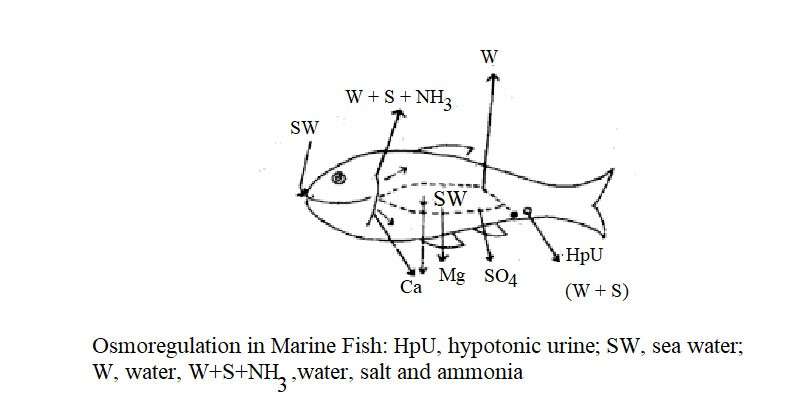
There are some species of marine bony fish that are more and others less stenohaline types and they can adapt to lower and higher salt concentrations than normal salt concentrations. Mudskippers (Periopthalmus) can tolerate salinity of up to 45 ppt in individual reservior. Moreover, many marine species can adapt continuously in freshwater, and cannot tolerate anything other than milkfish (Chanos) when the salinity is directly increased from 35 ppt to 0 ppt.
The higher concentration of calcium ions in marine fish is an important factor for adaptation to lower salinity. Since calcium reduces the penetration of salt and water into the cell. For example, slippery dick lived in coral reef region (Labridae-Halichoeres bivittatus) are healthy when they are fed a mixture of at least 1/10 percent salt and 9/10 percent fresh water filtered through calcium rich coral sand.
Osmoregulation in Diadromous Fishes
When an eel fish (Anguilla) reaches freshwater habitats through upstream migration, it is more likely to suffer from salt depletion and excess water than from dehydration and excess salt. When a baby salmon goes to sea through a downward expedition, they run into the opposite problem.
In both anadromous and catadromous, there is a multifaceted adaptation to osmregulation. These fish have glomerular kidneys which can be adapted by producing different amounts of urine in different salinity. In addition, fish have gills and oral membranes that can absorb and excrete certain ions.
In the case of eel fish (Anguilla), experiments have shown that their chloride cells can act as a unit of absorption and excretion. So diadromous fish can adapt to the freshwater or saltwater phase of the life cycle. Such adaptations are primarily dependent on gene-controlled physiological changes. For example, marine lampreys (Petromyzon) enter freshwater for breeding and cannot adapt to salinity higher than 18ppt, and baby salmon (Onchorhynchus and Salmo salar) cannot enter the sea successfully until chloride cells have developed.
Easy transfer depends on some anatomical features such as the proportion of gill and body surface of fish. Different species of Stickleback (Gasterosteus) may adapt to different levels in freshwater for migration along the shores for breeding purposes.
The activity of the endocrine glands changes spontaneously before the salt and water equilibrium techniques are changed. During or before migration various glands such as pituitary, thyroid, gonad are primarily involved in changes in physiological adaptation.
An increase in thyroid activity has been reported in salmon (Onchorhynchus) during downward migration. In addition, the thyroid gland plays a role in energy generation and other functions for the release of salt into seawater. Mature stickleback (Gasterosteus) chooses freshwater because changes in the pituitary and gonads affect hunger behavior in most cases. That is why it is important to determine time schedule during migration.
Osmoregulation in Shark, Rays and Skates
In the case of fish like sharks, rays and skates (Elasmobranchii), no water passes through the permeable membrane or slightly, so it is able to ignore the osmotic pressure like other fish. So they can control the internal osmotic pressure.
The freezing point of blood and tissue fluids of marine elasmobranch is more than 0.0-2.00 C which is slightly higher than that of sea water. Therefore, their blood is considered hypertonic rather than outside water. This hypertonicity is due to the fact that they have higher concentrations of chloride ions in their blood than in the blood of ray finned bony fish. 42-55% of the active component in their blood is nitrogenous compounds, most of which are urea.
The skin of marine elasmobranch contains 2-2.5% urea. Shark gills do not lose any urea. Such a structure is parallel to the mammalian renal artery amomg all other vertebrate organs. In the case of elasmobranch, some water enters through the gills and oral membranes, but the rest of the body surface is fairly impervious to water. As a result, a small amount of urea-containing hypertonic urine is produced. In the case of sharks, this amount is 2-24 ml / kg / 24 hours. However, the amount of glomeruler filtrate is 60 ml / kg / 24 hours. This water is reabsorbed in the proximal convuluted tubule.
In the case of Sharks, Rays and Skates, trimethyl amine oxide contributes to the formation of 8-12% or more of the osmotic pressure. Trimethyl amine oxide like urea, is reabsorbed from the glomerular filtrate of renal tubules to control osmotic pressure in the case of elasmobranch.
The water enters into the body of the marine elasmobranch through the gills, dilutes the blood and increases the flow of urine. As a result, blood and tissue urea decreases and urine flow decreases. Freshwater fish, on the other hand, use water to supply their urine and metabolic water. Salt is excreted from the kidneys and renal glands of marine elasmobranch.
Urine and the volume of the fluid in rectal gland is roughly the same, but the difference between the two fluid components is that the fluid in the rectal gland contains a small amount of Mg ++ ions with a hypertonic sodium chloride (Nacl solution). However, baby Elasmobranch and some freshwater species face some special osmotic problems.
Sharks, skates and rays carry babies or their eggs are covered with a hard impermeable egg shell containing urea. They develop in high urea environments and babies are born with urea retention techniques. The serum freezing point in their blood is about 0.0-1.00C. The value of freshwater fish is -0.570 C. This difference is -0.430 C or more due to the presence of urea in the blood and tissues and it has been observed that freshwater elasmobranch have superior glomerular kidneys and they produce large amounts of hypotonic urine. Nitrogen is mainly removed through gills as ammonia.
Urea is another excretory component in freshwater Elasmobranch. About 1/3 of the urea passes through the kidney and its ducts but more is removed through the gills. Elasmobranch lose chloride through diffusion and they produce relatively more urine, but freshwater sharks have not been known to absorb ions through gills.
Role of Hormones on Excretion and Osmoregulation
Various endocrine glands such as the hypothalamus, thyroid, suprarenal body, gonads and urophysis play important roles in maintaining salt-water balance and urine production in fish. The rate of filtration of the renal corpuscle is affected by hormones. Changes in blood pressure are also regulated by hormones. Several types of hormones, especially thyroxine is involved in osmoregulation. Adrenocortical hormone is produced by the suprarenal body and helps osmoregulation in fish.
The hormone acts on the cells of the renal tubules to alter the permeability and reabsorption rate of various components and can also affect renal excretion. Fish gills and kidneys participate in the osmoregulation and hormones also affect the filtration and absorption of gills. In higher vertebrates, the adrenal cortical hormone has an effect on balancing sodium and chlorine. In fish, this hormone plays a role in regulating the function of the gills and kidneys.
The blood of trout (Salvelinus, Salmo) contains hydrocortisone and corticosterone. Corticosterne reduces sodium elimination through the kidneys. It also affects the rate of sodium elimination and absorption from the gill by altering the permeability of the gill epithelium.
In eel fish (Anguilla), a medullary hormone called adrenaline, increases the transport capacity of the blood vessels. It reduces or stops chloride emissions completely. In migratory fish, prolactin hormone participate in the osmoregulation. Urohypophysis and other hormones play a role in osmoregulation (Bern 198).
Table: Differences between Euryhaline and stenohaline fish
|
Euryhaline Fish |
Stenohaline Fish |
|---|---|
|
They are able to withstand high salinity changes. |
They are not able to tolerate high salinity changes. |
|
They are able to migrate longer distances. |
They are able to migrate short distances. |
|
The group includes many dryradmous fish such as eel (Anguilla), Atlantic salmon (Salmo salar), Tenualosa ilisha, some stickleback (Gasterosteus) and killifish (Fundulus). |
This group usually includes freshwater fish and some marine bony fish. |
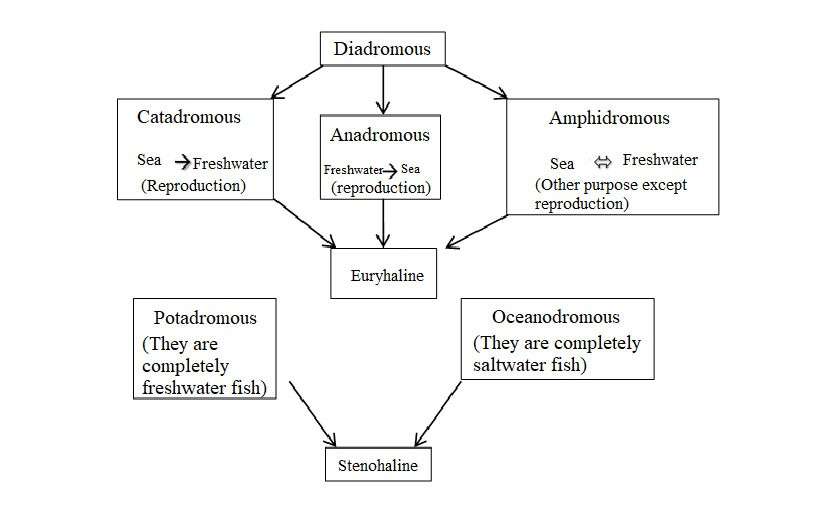
Figure: The course of migration of euryhaline and stenohaline fish.
Table: Difference between Excretion and Osmoregulation
|
Excretion |
Osmoregulation |
|---|---|
|
Excretion is the process of removing nitrogenous wastes from the body as a result of metabolism. |
The process by which the fish maintains the homeostasis process when there is a difference in the concentration of body fluids and the surrounding fluid is called osmoregulation. |
|
The kidneys, skin and gills take part in this process. |
In addition to the kidneys, skin and gills, the oral membrane and intestines also take part in this process. |
|
Components lost in this process do not have to be retrieved. |
In this process the lost elements like Calcium (Ca ++), Magnesium (Mg ++), Potassium (K +), Chloride (Cl–) etc. ions are reabsorbed or removed as required. |
|
Excretory components are produced as a result of the catalytic reaction of nitrogenous components. |
Osmotic elements are generated through mutual exchange. |
|
The excretions produced are harmful to the body and need to be removed. |
Re-absorption of lost salt and other elements and removal of excess material is vital to maintain balance. |
Table: Differences between anadromous and catadromous fish
|
Anadromous |
Catadromous |
|---|---|
|
Fish that move from salt water (sea) to freshwater for breeding purposes are called anadramous fish. |
Catadramous fish move from freshwater to saltwater (sea) for breeding purposes. |
|
They do not travel as far as catadramous. |
They travel long distances up to 4500 km. |
|
In this case, most of the adult fish that lay eggs (if there are no obstacles) go back to the sea. |
In this case, the adult fish dies after leaving the egg. |
|
Their young grow up in freshwater and reach maturity at sea. |
The larvae grow in the sea and return to the river when they reach the stage of Ilva. |
|
The best examples are: Tenualosa ilisha, Alosa, Salmon, Shad, Stripe bass and Sturgeon etc. | Notable examples include freshwater eel (Anguilla anguilla), European eel (Anguilla rostrata) and American eel (Anguilla vulgaris),etc. |
